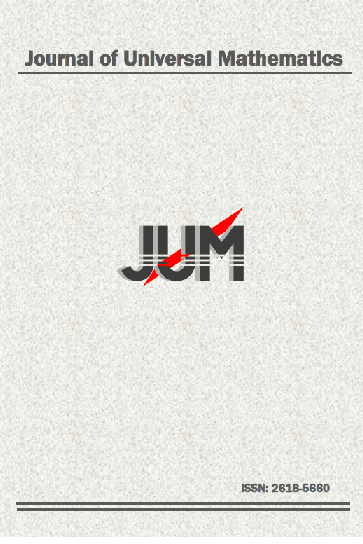A TILING APPROACH TO FIBONACCI p-NUMBERS
A TILING APPROACH TO FIBONACCI p-NUMBERS
___
- [1] S. Falcon and A. Plaza, On the Fibonacci k-Numbers, Solitons-Fractals. Vol. 32, N. 5, pp. 1615-24 (2007).
- [2] M. El-Mikkawy and T. Sogabe, A New Family of k-Fibonacci Numbers, Applied Mathematics and Computation, Vol. 215, pp.4456–4461 (2010).
- [3] Y. Tasyurdu and N. Cobanoglu and Z. Dilmen, On The A New Family of k-Fibonacci Numbers, Erzincan University Journal of Science and Technology. Vol. 9, N. 1, pp. 95-101 (2016).
- [4] J.P. Allouche and J. Johnson, Narayanas Cows and Delayed Morphisms, Articles of 3rd Computer Music Conference JIM96 (1996).
- [5] A.P. Stakhov, Introduction into Algorithmic Measurement Theory, Soviet Radio, Moskow, (1977).
- [6] A.P. Stakhov, Fibonacci Matrices A Generalization of the Cassini Formula and A New Coding Theory, Solitons and Fractals, Vol. 30, pp. 56–66 (2006).
- [7] A. Stakhov and B. Rozin, Theory of Binet Formulas for Fibonacci and Lucas p-Numbers, Solitons and Fractals, Vol. 27, N. 5, pp. 1163–1177 (2006).
- [8] E. Kilic, The Binet Formula Sums and Representations of Generalized Fibonacci p-numbers, Eur. J. Combin, Vol. 29, pp.701–711 (2008).
- [9] K. Kuhapatanakul, The Fibonacci p-Numbers and Pascals Triangle, Cogent Mathematics, Vol. 3, N. 1, pp.7 (2016).
- [10] Y.K.A. Panwar, Note on the Generalized k-Fibonacci Sequence, MTU Journal of Engineering and Natural Sciences, Vol. 2, N.2, pp. 29-39 (2021).
- [11] T.Koshy, Fibonacci and Lucas Numbers with Applications, Wiley, New York NY USA, (2001).
- [12] Y. Tasyurdu, Generalized (p, q)-Fibonacci-Like Sequences and Their Properties, Journal of Mathematics Research, Vol. 11, N. 6, pp. 43-52 (2019).
- [13] M. Kwasnik and I. W loch, The Total Number of Generalized Stable Sets and Kernels of Graphs, Ars Combin, Vol. 55, pp. 139–146 (2000).
- [14] U. Bednarz, A. W loch and M. Wo lowiec-Musia, Distance Fibonacci Numbers Their Interpretations and Matrix Generators, Commentat. Math, Vol. 53, N. 1, pp. 35–46 (2013).
- [15] I. W loch and U. Bednarz and D. Brod and A. W loch and M. Wo lowiec-Musia, One New Type of Distance Fibonacci numbers, Discrete Applied Mathematics, Vol. 161, N. (16-17), pp. 2695-2701 (2013).
- [16] A.B. Brother, Fibonacci. Numbers and Geometry, The Fibonacci Quarterly, Vol. 10, N. 3, pp. 303-318 (1972).
- [17] H.L. Holden, Fibonacci Tiles, The Fibonacci Quarterly, Vol. 13, N. 1, pp. 45-49 (1975).
- [18] E. Verner and J.R. Hoggatt and K. Alladi, Generalized Fibonacci Tiling, Fibonacci Quarterly, Vol. 13 N. 2, pp. 137-149(1974).
- [19] R.C. Brigham and R.M. Caron and P.Z. Chinn and R.P. Grimaldi, A Tiling Scheme for the Fibonacci Numbers, J. Recreational Math, Vol. 28, N. 1, pp. 10–17 (1996-97).
- [20] A.T. Benjamin and J.J. Quinn, Proofs That Really Count The Art of Combinatorial, Proof Mathematical Association of America, (2003).
- [21] A.T. Benjamin and J.J. Quinn, The Fibonacci Numbers Exposed More Discretely, Math. Magazine, Vol. 33, pp. 182–192 (2002).
- ISSN: 2618-5660
- Başlangıç: 2018
- Yayıncı: Gökhan ÇUVALCIOĞLU
ON INTERNAL CATEGORIES IN HIGHER DIMENSIONAL GROUPS
Ummahan EGE ARSLAN, Elis SOYLU YILMAZ
A NOTE ON KENMOTSU MANIFOLDS ADMITTING GENERALIZED TANAKA-WEBSTER CONNECTION
Mustafa YILDIRIM, Ramazan Çınar KAYA
Ahmet Mücahid GÖKTAŞ, Koray YILMAZ, Orkun TAŞBOZAN
QUADRATIC MODULES OF LIE ALGEBRAS FIBRED OVER NIL(2)-MODULES OF LIE ALGEBRAS
Hatice TAŞBOZAN, Aydın GÜZELKOKAR
POINTWISE INNER AUTOMORPHISMS OF RELATIVELY FREE LIE ALGEBRAS
INCLUSION THEOREMS IN THE FUNCTION SPACES WITH WIGNER TRANSFORM
A NEW TYPE LORENTZIAN ALMOST PARA CONTACT MANIFOLD
DYNAMICAL BEHAVIOURS OF A DISCRETIZED MODEL WITH MICHAELIS-MENTEN HARVESTING RATE
Nihal ÖZDOĞAN, Mevlüde YAKIT ONGUN
INTUITIONISTIC MULTIPLICATIVE SET APPROACH FOR GREEN SUPPLIER SELECTION PROBLEM USING TODIM METHOD
NUMERICAL SIMULATION OF GENERALIZED OSKOLKOV EQUATION VIA THE SEPTIC B-SPLINE COLLOCATION METHOD
Seydi Battal Gazi KARAKOÇ, Derya SUCU, Mohamad Arif TAGHACHİ
